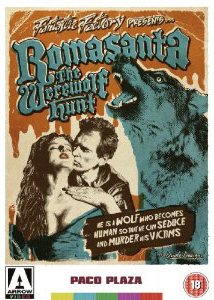
Any of you who may have read my review of Warlock may understand that I struggle to be unbiased where British actor Julian Sands is concerned - and Warlock is one thing, but in Romasanta: the Werewolf Hunt we have his Satanic charm transformed into something altogether more evocative and sensual. In short, this lady hack didn’t stand a chance with Romasanta, but that aside, I want to stress that this is a genuinely outstanding period horror which melds lust and lustmord in a unique way. I’ll go yet further - this is one of the most overlooked Gothic horror films of recent years.
The year is 1851: villages in the Northern Spanish region of Galicia are being besieged by wolves which indiscriminately attack humans as well as livestock. We meet a family of three sisters - the eldest, Maria (Maru Valdivielso), Bárbara (Elsa Pataky) and Teresa (Luna McGill). Maria is in a relationship with an itinerant trader called Manuel Romasanta (Sands) who suggests that the couple leaves the village with Teresa for a safer area: life in the village is now getting desperate, with a curfew in place and bounties being placed on the heads of the dangerous wolves. Maria is all too happy to go and to leave her beautiful younger sister Bárbara behind: she (rightly) suspects that there is some attraction between her sister and her man, although she promises to send for her when she has found work in the new village.
En route, we get our first glimpse of Romasanta’s true nature. He helps little Teresa capture a songbird, but then cannot suppress his killer instinct as he tortures the creature. This just a hint of what is to come. Back at the old village, the authorities are becoming less and less convinced that the human casualties on their hands were killed by wolves at all - or at least, that these were simple wolf attacks. The police investigation joins forces with modern pseudoscience in an attempt to crack what looks like a nascent serial killer case.
Then, Romasanta arrives back in the village for Bárbara, telling her that her sisters are now settled and she can join them. Sexual tensions again begin to stir…oh my, do they begin to stir…but as their romance develops, it appears that Romasanta is being hunted by a former associate, and Bárbara also begins to suspect him.
This is, to me, a horror with genuinely sensual overtones, and I don’t mean that simply in a sexual sense. This is a film about carnality - here lycanthropy hinges less upon fantastical transformation scenes (although there is one example) and more on its more literal earlier sense of man consumed by animal instinct. We see various parties trying to come to terms with this: not only does Romasanta alternate between intense pleasure and self-loathing at his actions, but religion, law and order, and modern medicine also try to get to grips with his brand of criminality. And then there’s Bárbara…in many ways she’s the reverse side of the coin to Romasanta, which means she can compliment him perfectly - or, as occurs, where she placates him, evidence of his true nature motivates her to undertake action until she becomes the most important character in the film.
At all times, this feels to me like a unique take on the werewolf genre. There’s no moral high ground: characters are ambiguous and complex, their motivations interesting and not passed over in order to render this down into a simple creature feature. The way the film looks is simply stunning, and is presented in clear, realistic tones, with lots of warmth (sunshine, firelight) rendered in a completely non-lurid style. Hammer horror, this isn’t. As for the camerawork! - There are glorious shots here, such as the almost-symmetrical aerial shot of the wolf carcasses (later echoed as Bárbara lights pyres around her property to ward off the remaining wolves) and the flaming coach sequence is amazing. Overlaid over all of this is an impeccable original score by Mikel Salas and a superb array of locations.
I realise I’m waxing lyrical over this film, so in the interests of balance I suppose I should criticise it as well. Hmmm. Well, one decision I’m not so sure of was to redub the film with English speakers. I can see that, having an English male lead amongst a host of Spanish accents may have sounded odd, but I do think it’s a shame in some ways. When you have an actress like Macarena Gómez being redubbed - an actress who speaks English very well (she was the Priestess in Stuart Gordon’s Dagon) - it reduces that actress’s ownership of her role, even if it’s a small role in the grand scheme of things.
It’s a minor quibble though, and having revisited Romasanta I can safely say that this is one of my favourite films. It definitely deserves a new wave of attention and fans of period horror will find plenty to enjoy here. The Arrow release comes with a host of extras, too. We get a twenty-minute documentary called Lycanthropes, Lunacy and the Last Days of the Fantastic Factory, where Brian Yuzna talks about the time he spent in Spain and what he hoped to achieve there. There’s also a short feature on the music composition, some twelve minutes of deleted scenes, a ‘Making Of’ piece and the film’s trailer.
Romasanta forms part of the four-film Fantastic Factory box set (alongside Beyond Re-animator, Faust: Love of the Damned and Arachnid) but it is also pegged for an individual release on May 16th 2011.
Review by Keri O’Shea
| Released by Arrow Video |
| Region 2 - PAL |
| Rated 18 |
| Extras : |
| see main review |